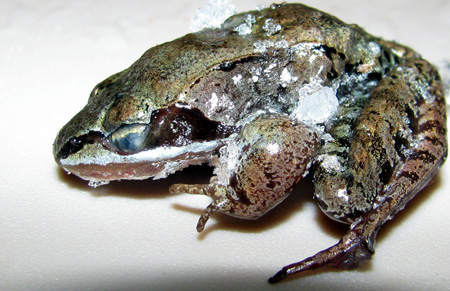Certain frogs can be frozen solid then thawed and continue living

Certain Frogs Can Be Frozen Solid then Thawed - and Continue Living

Nature always finds a way to surprise us with its extraordinary adaptations. One such fascinating phenomenon involves certain frog species that can withstand the freezing cold temperatures of winter by becoming completely frozen and yet miraculously survive when thawed. This incredible ability is an adaptation that allows these cold-blooded amphibians to thrive in some of the harshest environments on Earth.

The phenomenon of freezing and thawing is known as cryopreservation, and it is not limited to the tiny ice crystals we commonly associate with freezing temperatures. These frogs go beyond the typical freezing point of water and can withstand temperatures as low as -8°C to -16°C (17°F to 3°F). Their amazing survival techniques have captivated scientists and researchers for years.
How is it possible for these frogs to endure being frozen solid? It all comes down to a series of ingenious adaptations that ensure their survival. Unlike other animals that require specialized antifreeze proteins or mechanisms to prevent ice formation in their cells, these frogs naturally synthesize a unique substance called glucose.
Glucose acts as a cryoprotectant, which means it protects the frog’s cells and tissues from damage caused by ice crystals. When the freezing temperatures set in, these remarkable frogs produce high levels of glucose, which floods their organs and tissues, effectively preventing ice formation and ensuring that the cells do not dehydrate during the freezing process.
As the temperature drops further, the frog’s metabolism slows down, and its heart and breathing rates drastically decrease. Eventually, the frog enters a state of suspended animation, where its body processes almost come to a halt. It is during this time that the frog appears frozen solid, with ice crystals forming on its skin and body.
When spring arrives and temperatures begin to rise again, the frog starts to thaw. The glucose stored in its body acts as an energy source during this crucial stage. As the ice crystals melt and the frog’s body temperature rises, its physiology gradually recovers, and it returns to its active state.
Although the process of freezing and thawing may cause some cellular damage, the frog’s remarkable ability to repair and regenerate its cells allows it to recover fully, returning to its normal activities as if nothing happened. This adaptation enables these extraordinary creatures to survive in freezing environments where other organisms would perish.
The ability of these frogs to freeze and thaw is a biological marvel that continues to intrigue scientists. Researchers are studying the unique properties of the glucose produced by these frogs, hoping to unlock the secrets of cryopreservation and apply them in various fields of science and medicine.
In conclusion, the ability of certain frogs to be frozen solid then thawed - and continue living - is an astonishing natural adaptation. These exceptional creatures have evolved over time to survive in frozen conditions by producing glucose, which acts as a cryoprotectant and helps protect their cells and tissues. This unique ability holds great promise for future research and advancements in cryopreservation and related areas.
Source: National Geographic Blog - How Arctic Frogs Survive Being Frozen Alive
Tags
Share
Related Posts
Quick Links
Legal Stuff

